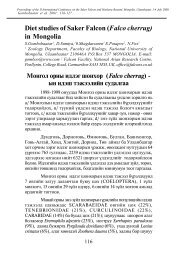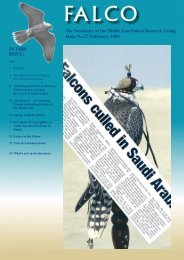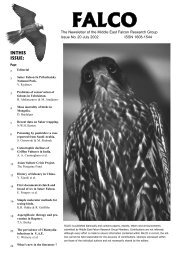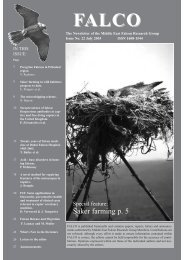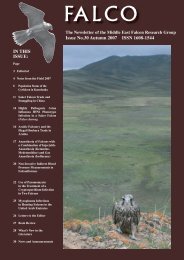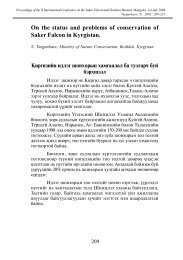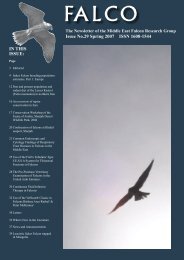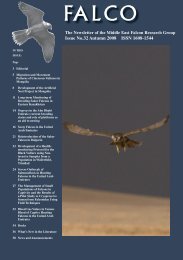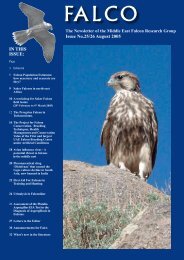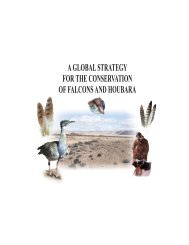Falco cherrug - International Wildlife Consultants Ltd.
Falco cherrug - International Wildlife Consultants Ltd.
Falco cherrug - International Wildlife Consultants Ltd.
Create successful ePaper yourself
Turn your PDF publications into a flip-book with our unique Google optimized e-Paper software.
of the Imperials), none of the Sakers occupy Imperial Eagle<br />
nests (in contrast to the north-eastern Saker populations).<br />
A fairly large breeding enclave is located in the<br />
Guberlinskiy hillocks, however only part of these hillocks is<br />
located in the Orenburg District, the rest being in<br />
Kazakhstan. In the Orenburg part of the hillocks we know<br />
of 6 breeding territories.<br />
The numbers of Sakers in the Guberlinskiy<br />
hillocks and South-Urals (Bashkiria and Ore burg District)<br />
is 15-35 pairs.<br />
We estimate the total number of Sakers in western<br />
Siberia to be 150-220 pairs (180 median), including a few<br />
pairs in the Bashkiria and Orenburg Districts.<br />
Between the Ural mountains and the Volga river<br />
the Saker is scarce. Constant breeding territories are known<br />
only in the Syrt highlands bordering the Urals. In the<br />
Zavolzhye for 1998-2002 we know of 5 breeding territories.<br />
In the forest-steppes of the Upper Zavolzhye we know 2<br />
pairs of Sakers, both bred in the Orenburg district. One pair<br />
was breeding for 2 years in a raven’s nest on top of a concrete<br />
electricity pylon and then disappeared; the second pair<br />
bred for one season in a common buzzard’s nest at the edge<br />
of a pine-forest patch on a river terrace. In the steppes of the<br />
Zavolzhye we found 3 Saker breeding territories: one was<br />
located in the Ural river valley in the Orenburg District (for<br />
one season), two others were in the Siniy Syrt of the Samara<br />
District (both unsuccessful). It appears that there is no area<br />
in the European part of Russia with regular Saker breeding;<br />
however some stray pairs breed in various places. The total<br />
number of Sakers between the Volga and the Urals does not<br />
exceed 25 pairs. In the areas west from the Volga river<br />
breeding is unlikely, as in the past year there were no sightings<br />
of this species in the last known breeding locations in<br />
the Don basin or in areas westwards from the Volga<br />
(Antonchikov and Piskunov 2003, Galushin et al. 2001).<br />
The total number of Sakers in the area under question<br />
is 1815-2425 pairs (Table 1).<br />
Isolated enclaves of Sakers are found in the<br />
steppes near Baikal Lake. In these areas there are 300-500<br />
pairs (Ryabtsev 1984, 1995, 1997, 1998, Goroshko et al.<br />
2000). With these numbers it is possible to estimate the total<br />
current population of Sakers in Russia as being 2115-2925<br />
breeding pairs.<br />
Depending on food availability and weather conditions<br />
only 56-95 % of pairs breed in any particular year, and<br />
only 24-76% are successful. In the Altay-Sayan region we<br />
observed significantly less successful pairs than in western<br />
Siberia and the Urals (Table 2). This is, perhaps, caused by<br />
the more severe conditions and higher poaching rates.<br />
Across all of Russia only 41% of breeding attempts are suc-<br />
cessful (Karyakin 2003). As a result it is possible to conclude<br />
that the core of the Russian Saker population consists of 860-<br />
1200 successful pairs.<br />
In general there is a negative trend in the number of<br />
Sakers across Russia. Nevertheless, in contrast to the almostdisappeared<br />
population of the European part of Russia and<br />
the declining eastern population, the number of Sakers in the<br />
Urals and western Siberia is more or less stable. In some<br />
enclaves numbers are even growing (Urals proper and<br />
regions adjoining the Urals from the east). Despite the stability<br />
in this part of the range (c. 11% of the total numbers in<br />
Russia) the overall trend is negative (Table 1).<br />
Nesting habitats and breeding rate<br />
In the Altay-Sayan region most Sakers breed on<br />
cliffs, regardless of whether or not forest is present in the<br />
immediate vicinity. The Sakers in this region opt for crags or<br />
pinnacles. They occupy the nests of upland buzzard, raven,<br />
and to a lesser extent, other species. In the southern Urals the<br />
Saker also prefers cliffs, and raven nests dominate the list of<br />
nest-providers. In the western Siberian and European part of<br />
Russia Sakers nest almost exclusively in trees, mostly pines<br />
(with Imperial Eagles as the main nest provider) (Table 3).<br />
In the Altay-Sayan region the clutch size was 2.7±<br />
0.42 (average ± SD), range 1-5 (N=15). The brood size in<br />
successful nests was 2.5±0.09, range 1-5, N=139.<br />
In western Siberia the only known clutch had 3<br />
eggs, however, the average clutch size has to be higher, as<br />
brood sizes of 4 dominate in the sample. The average brood<br />
size in this region was 2.9±0.18, range 1-4, N=17.<br />
In the Volga-Ural region the only known clutch contained<br />
4 eggs. It also looks as if the majority of clutches contained<br />
4 eggs, as judged from the brood size. The latter in this<br />
region was 2.9 ±0.88, range 1-4, N=24. Brood size observed<br />
after fledging was 2.8±0.80, range 1-4, N=13.<br />
Egg sizes were 53.1-58.6 x 40.9x44.5 mm, average<br />
55.9±0.56 x 42.8±0.19 (N=22).<br />
Discussion<br />
The data from the literature, as well as data from the<br />
surveys mentioned in this study suggest that the numbers of<br />
Sakers east from the Urals are stable if somewhat declining,<br />
whereas the population in the European part of Russia has<br />
ceased to exist. Here we hypothesise on the causes of the<br />
rapid decline in the European part of Russia.<br />
The data from the literature given in the review at<br />
the beginning of the paper, as well as that given by Bragin<br />
(2001), are displayed in the map shown in Figure 6. It is possible<br />
to suggest that at the beginning of 20 th Century there<br />
were the following large enclaves of Sakers: between the<br />
Table 2. Occupancy of Saker nests as seen in surveys.<br />
Year Territories checked Occupancy Number of successful<br />
Successful nests per<br />
visited territory<br />
Successful nests of<br />
occupied territories<br />
Chicks per successful<br />
pair<br />
Total Occupied total Visited<br />
twice<br />
1999 98 53 54.08 52 3 53.06 98.11 2.25+0.08 (n=51) (1-3)<br />
2000 83 20 24.1 20 1 24.1 100 2.38+0.12 (n=13) (1-3)<br />
2001 61 31 50.82 29 12 47.54 93.55 2.44+0.28 (n=25) (1-4)<br />
2002 102 46 45.1 45 19 44.12 97.83 3.00+0.28 (n=37) (1-5)<br />
2003 77 46 59.74 20 2 25.97 43.48 2.69+0.30 (n=37) (1-4)<br />
Total 421 196 46.56 166 37 39.43 84.69 2.54+0.09 (n=139) (1-5)<br />
7



